The Garmin Instinct Solar Tactical is an outdoor sport watch that gets its energy from the sun and has military ambitions. It should be super, but is it? Enjoy the review!
- Weight: 53 grams
- Size: 45 x 45 x 15,3 mm
- Wrist size: 132-224 mm
- Price: € 399,99/ $ 449,99/ £359,99
Let me start with a bold remark: I have never been a great fan of Garmin outdoor watches. And… Garmin is not to blame; I am a small guy with small wrists and the Garmins that I tried in the past were just too big for me. I liked their function, for sure. With the Garmin Instinct series the US-based brand totally changed the ballgame for me. About half a year ago I gave Garmin a call and asked if I could do a review on one of the Garmin Instinct models. First they sent me the Garmin Instinct Tactical. Because of the release of the Garmin Instinct Solar Tactical I decided to go for that solar powered model. Garmin was so friendly to exchange the watches and I continued testing.
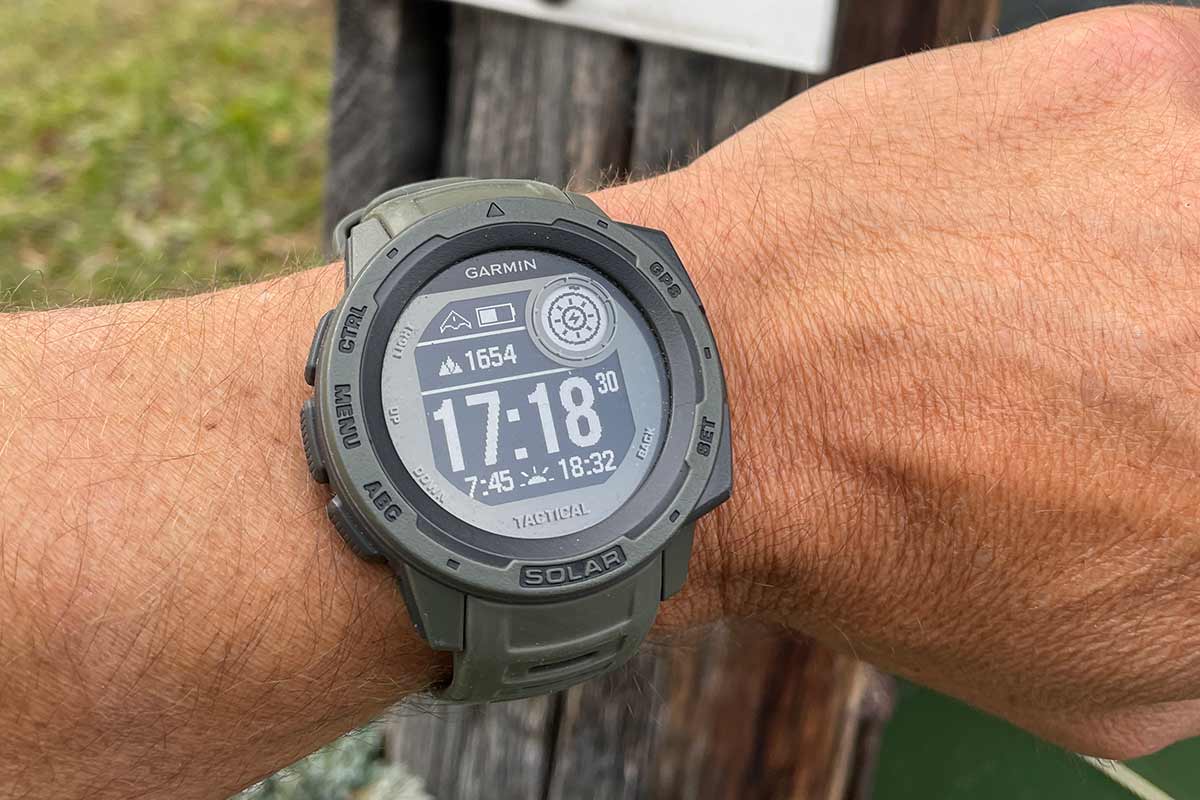
Size and weight
Before I start talking about the solar charging system in the Garmin, let’s begin with the bare numbers. Garmin claims a weight of 53 grams and a size of 45 x 45 x 15,3 mm. I put the Garmin Instinct Solar Tactical on my precise and calibrated scale and weighed the Instinct at 53,6 grams. I checked the size too and that one is spot on. Maybe you have seen my review on the Polar Grit X and remember the weight of 65,6 grams. The funny thing is that in retrospect I experience the Polar now as heavy – also my beloved Suunto Core – and think that the Garmin Instinct Solar Tactical is as light as a feather.
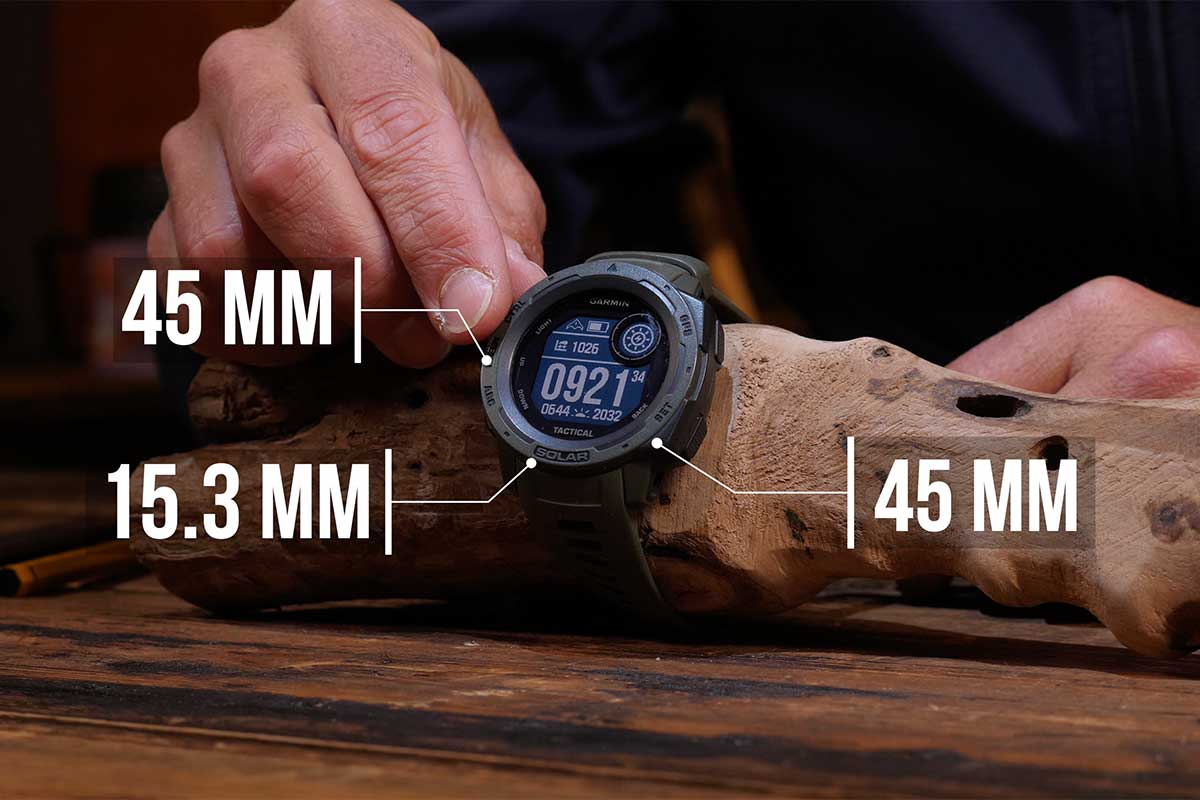
Materials
This low weight has to do with the materials the Garmin is made of: 100% fiber enhanced polymers. Or in non-polite consumer language, plastic. This ‘plastic’ is not only light but also very strong and it feels nice – warm – to the skin. The 22 mm wide wristband is made of silicon with a fixture from metal. The glass of the watch face is made from Power Glass which is in fact Corning Gorilla Glass.
Charging the Garmin Instinct Solar Tactical Part 1
As mentioned above, the main reason why I wanted to review the Garmin Instinct Solar Tactical is because of the fact that it is able to be charged by the sun. The watch face is a small solar panel. Or in fact two layers of solar panels. The light gray area is a 100% solar panel that converts for 100% the sunlight into energy that is stored in the battery. The darker area is a 10% solar panel that is transparent for 90% because it sits on top of the display that displays all the numbers and symbols. As soon as sun rays hit the solar panel the watch starts charging. In the top left side of the screen a little circle – the Solar Intensity panel – shows the amount of sun that hits the Garmin. It is also possible to switch to a dedicated screen that shows how much light has been hitting the Garmin in the past hours.

When I took the Garmin Instinct Solar Tactical out of its package I put it into the sun and nothing happened. In the package there is of course a USB-cable with a special connector that connects to the back of the watch case. So I charged the Garmin this way. I’ll get back on the solar charging later, because there is a little bit more than meets the eye.
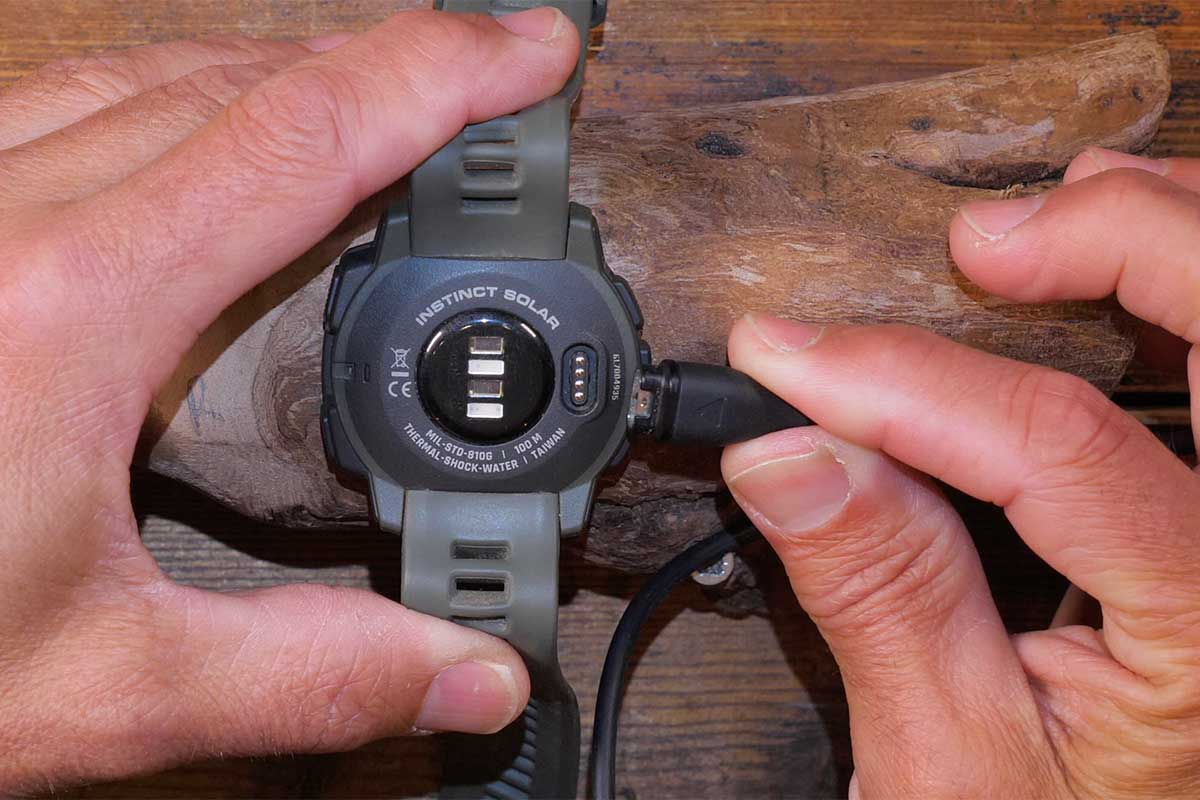
Buttons
The Garmin Instinct Solar Tactical is operated by pressing buttons. In this respect it is different than the majority of smartwatches nowadays. They all have touchscreens. With the Instinct I never make touchscreen mistakes or have the irritation of things not working due to wet fingers.
The Garmins buttons are excellent. They are big enough to be used with cold hands and fingers. Also being gloved up with medium thick ‘tactical’ gloves is not a problem. Thicker winter gloves do not always agree with the buttons. The buttons have a nice structure that prevents slipping off the buttons. Although the buttons are at the surface of the watch case, it never happened to me that I pressed the buttons accidentally. Some watches are very prone to sleeves pressing buttons.
Button functions
It is not my ambition to write a full manual about the Garmin Instinct Solar Tactical but let me talk you through the functions of the buttons. This is quite basic and important for the rest of the review.
Top Left: Light and Control (CTRL) button. Press to turn the watch on. Simply pressing it switches the backlight on and off. Press and hold activates the control menu.
Middle Left: Menu/scroll (Menu) button. Press to scroll UP through the widget loop and menus. Press and hold to view the menu.
Bottom Left: ABC/scroll (ABC) button. Press to scroll DOWN through the widget loop and menus. Press and hold to view Altimeter, Barometer and Compass.
Top Right: GPS (GPS) button. Pressing shows the activity list and also it starts or stops an activity. Press it again to choose an option in a menu. Press and hold shows the GPS coordinates and saves your location.
Bottom Right: Back/set (SET) Button: Press to get back to the previous screen. Press and hold to view the clock menu.
Sport watch
Although the Garmin Instinct Solar Tactical with its green color might look like an 100% military outdoor watch, this is not the case. The whole Instinct family has a sports and training heart. It’s just a matter of pushing the right buttons. Pressing the GPS button brings me into the screen where I choose the activity that I prefer. In my case it is mostly running and biking but there are many to choose from. Pressing the GPS button again starts the activity. Like most sports watches the Garmin Instinct Solar Tactical logs everything from distance to time to laps and of course heart rate.
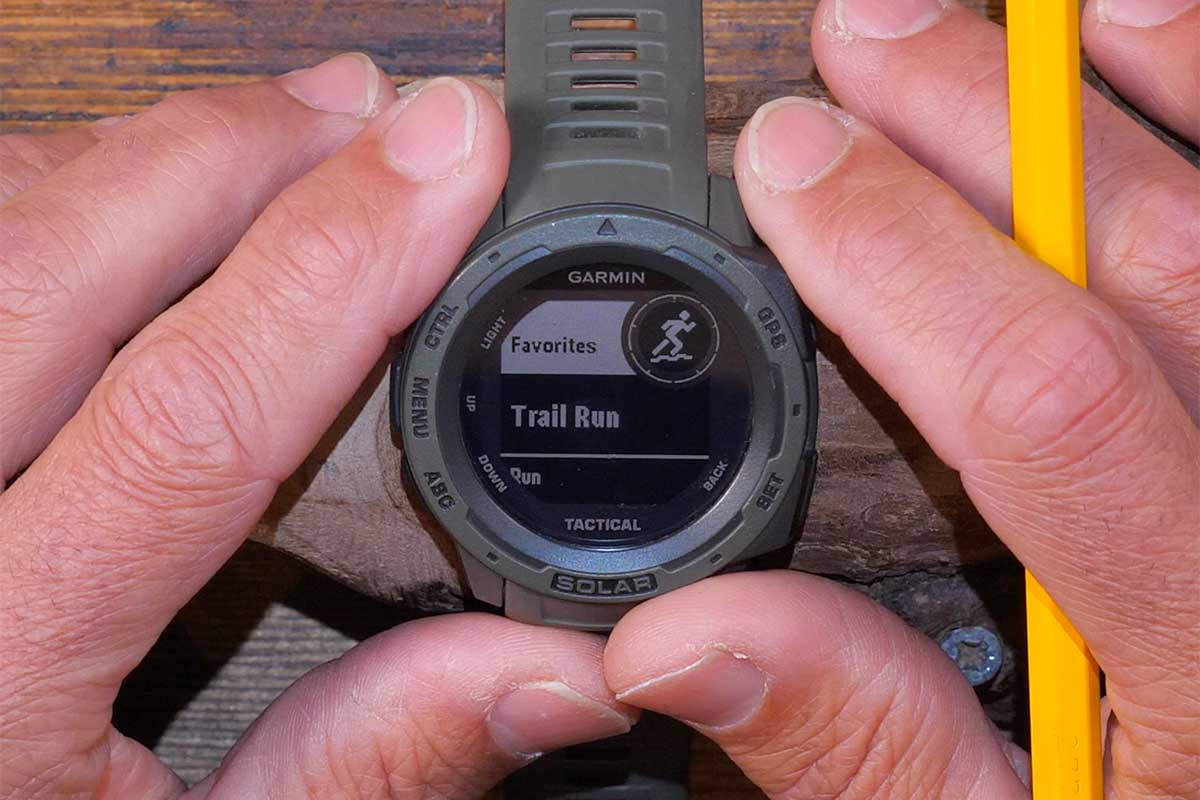
Heart rate
The heart rate is measured with an optical sensor on the bottom of the Instinct. What I do like is that the sensor is a little ‘glass’ hill that incorporates the LEDs and the sensors and that this hill is perfectly smooth. I have tested other watches – like the Polar Grit X – where this hill is not that smooth and therefore not super comfy. The LEDs underneath the Instinct are green. This light is transmitted into the blood veins and the sensors do their job. The LED/sensor combination also has the possibility to measure the amount of oxygen in the blood. In case you are interested in this…
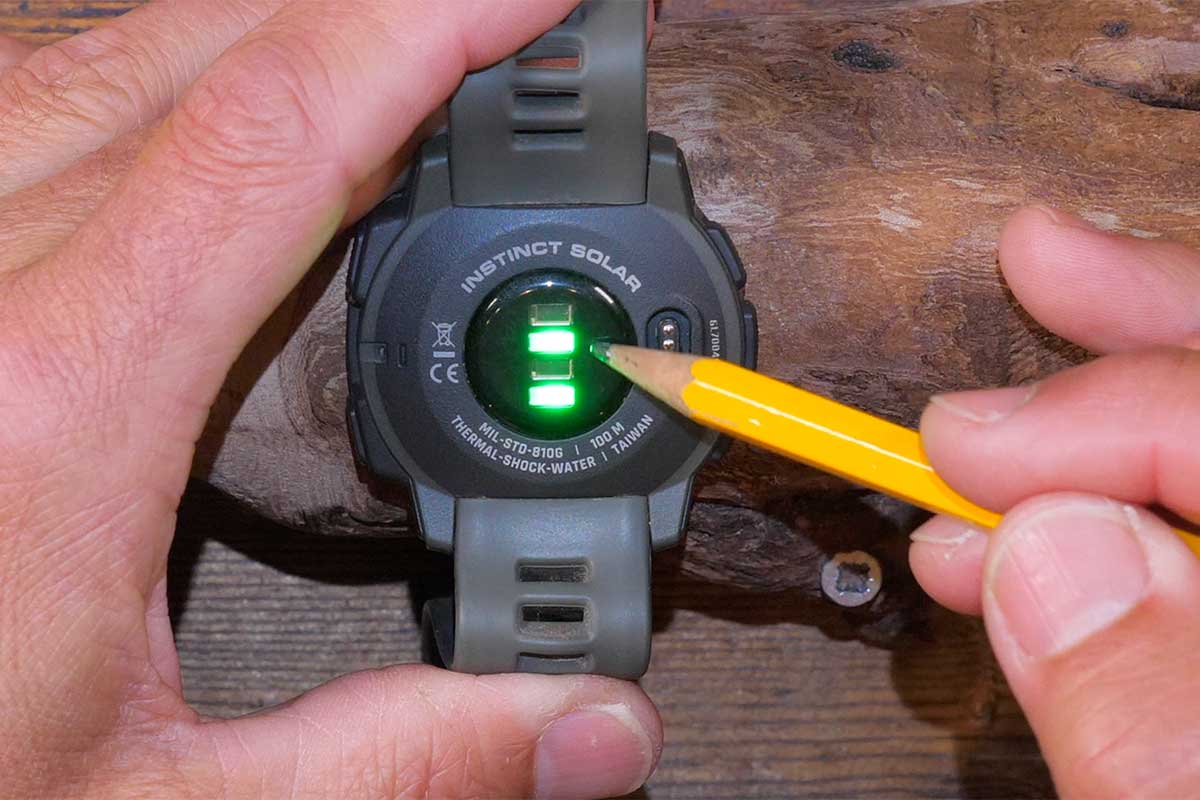
So, the Garmin Instinct Solar Tactical is a sports watch that measures and registers what we generally want. That is good. But what about its outdoor capabilities? Should be good since it is the TACTICAL version.
GPS
As with any smart device nowadays the Garmin Instinct Solar Tactical has a gps on board and I am not going into it in depth since I take it for granted it is doing its job. The Garmin uses satellites from GPS (the American system), GLONASS (the Russians) and GALLIEO (the Europeans) to pinpoint its place on earth. Whenever I start an activity the gps finds my place on earth quickly and is as accurate as we would expect from a gps. The gps is used for routing, waypoints, track back function and all the other regular gps functions.
ABC
Let’s get into the details of the ABC – Altimeter, Barometer and Compass – button.
Pressing the ABC-button a few seconds reveals the first screen: the Compass. Press it again but shortly and I am on the Altimeter screen and repeating this gets me the Barometer screen. So… ABC should be CAB but that was probably not a marketing option. Let me go in depth on all three of them and let’s start with the C.
Compass screen
The compass screen shows the bearing when you open it and the bearing is clearly visible in large numbers in the right hand corner; the direction is also shown with N, S, E, W and everything in between. By pressing the GPS button a menu opens. In this menu I can calibrate the compass, change what the display shows – degrees or milliradians -, I can change the North Reference from True, Magnetic, Grid or to my own preference. This is good because now I can change to wherever I am on this planet and be accurate. Did you know that the magnetic North is not everywhere the same way and that it changes from year to year? That is why you should know how a compass works when you are going out.

The second thing that the compass does, is help me find my route. I can lock a bearing and the compass will show me the deviation; how much I am off the straight line to that point. It also shows the distance to that point and shows an arrow with a bend that implies that a turn is to be expected at a distance that is also shown.
Altimeter screen
The Altimeter screen appears after pressing the ABC-button a few seconds and then pressing it shortly two times. The altimeter shows the current altitude in the right hand corner cirkel and shows the altimeter trend from the last 4 hours. It is shown in graphics and above it is the highest and lowest height shown in numbers. The information on the screen is very clear and easy to read and also hard to misinterpret. But don’t forget to read the chapter about the calibration of the altimeter below.
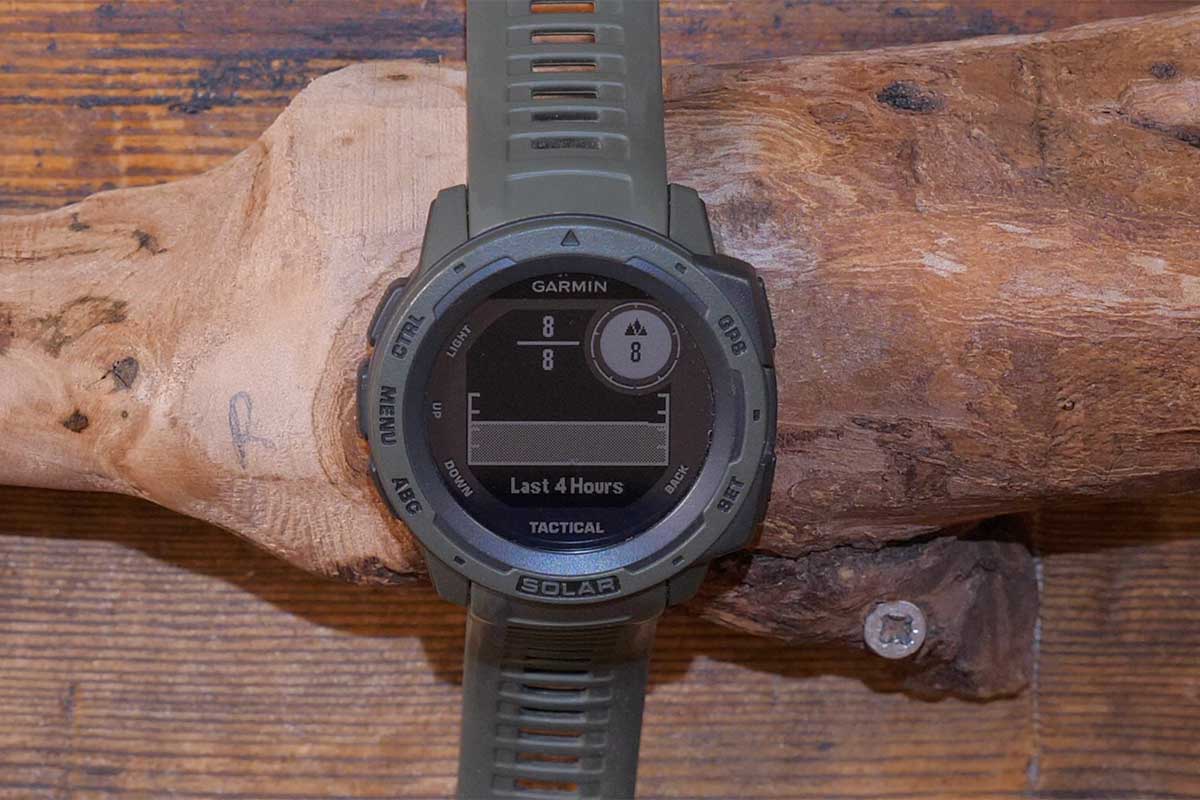
Barometer screen
The Barometer screen appears after pressing the ABC-button a few seconds and then pressing it shortly three times.The barometer screen looks very similar to the altimeter screen. In the right hand corner cirkel the current barometric pressure is shown. Left to the cirkel the lowest and the highest pressure are shown above each other. The bottom of the screen is occupied by the barometric pressure trend from the past 6 hours. Same remarks here as in the paragraph about the altimeter.
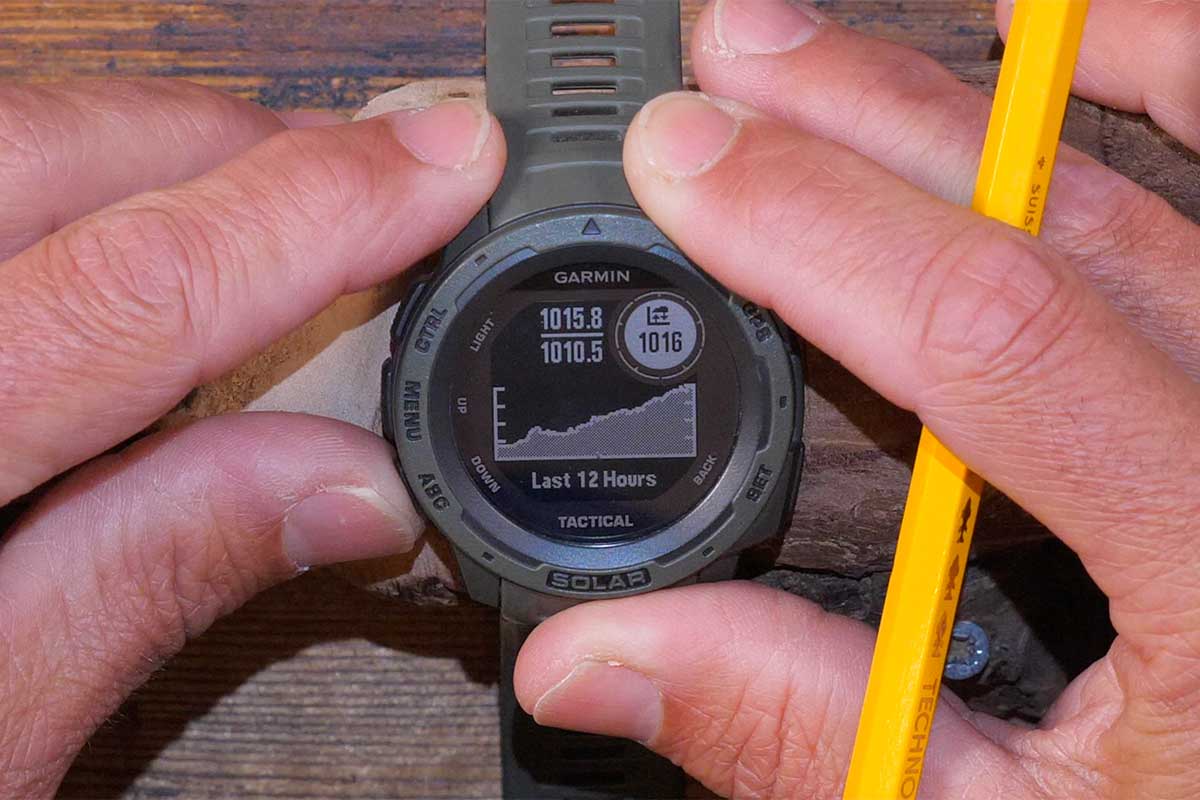
Altimeter and barometer need to know
To take full advantage of the altimeter and barometer you need to know how the two technically work.
The Garmin uses a pressure sensor inside the watch to register the air or barometric pressure. This pressure is used for the barometer – logical – and is also used for the calculation of the altitude.
When using the altimeter there are a few very important basics that you should know about how air and air pressure sensors work. The pressure sensor in a watch does not know whether a pressure change is the result of a weather change or a change in height. Imagine: You have your watch in the altimeter position and you spend the night in a mountain hut at an altitude of 2500 meters. While you are sleeping a low-pressure weather front is approaching. The pressure sensor registers this and the watch translates this as an increase in height. Without having moved a single meter, you wake up at 3000 meters. You will therefore have to keep a close eye on the weather when you are using the watch as an altimeter or as a barometer.
In addition, it is important to calibrate regularly. In the case of the altimeter, enter a reference altitude. For example, in the hut which height is exactly on the map. On the Garmin Instinct Solar Tactical – the Instinct series – this is possible. But there is a bit more going on.
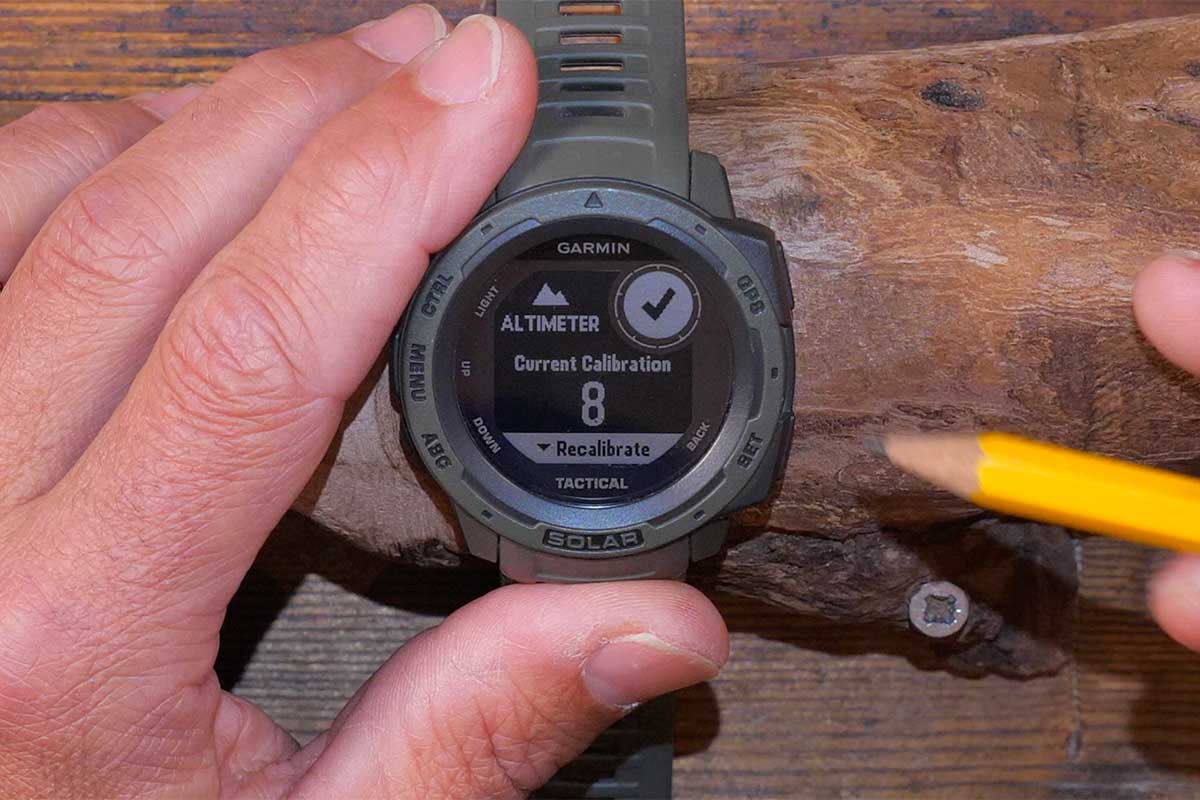
By default – Auto position on screen – the Instinct monitors changes in pressure and uses an algorithm to decide if this change is a result of changing location – up or down the mountain – or the result of changing weather.
A change by moving up or down the mountain leads to a fast changing barometric pressure and because of the algorithm the watch assumes that the altimeter is in the lead. It ‘locks’ into altimeter mode – and this is the nifty part – uses the barometric pressure as a constant value to recalculate the altimeter height.
When the Instinct notices that changes in barometric pressure are only occurring very slowly, the watch assumes that changes are not the result of movement and it puts the barometer in the lead. It ‘locks’ into barometer mode and uses the constant value to recalculate the barometric pressure.
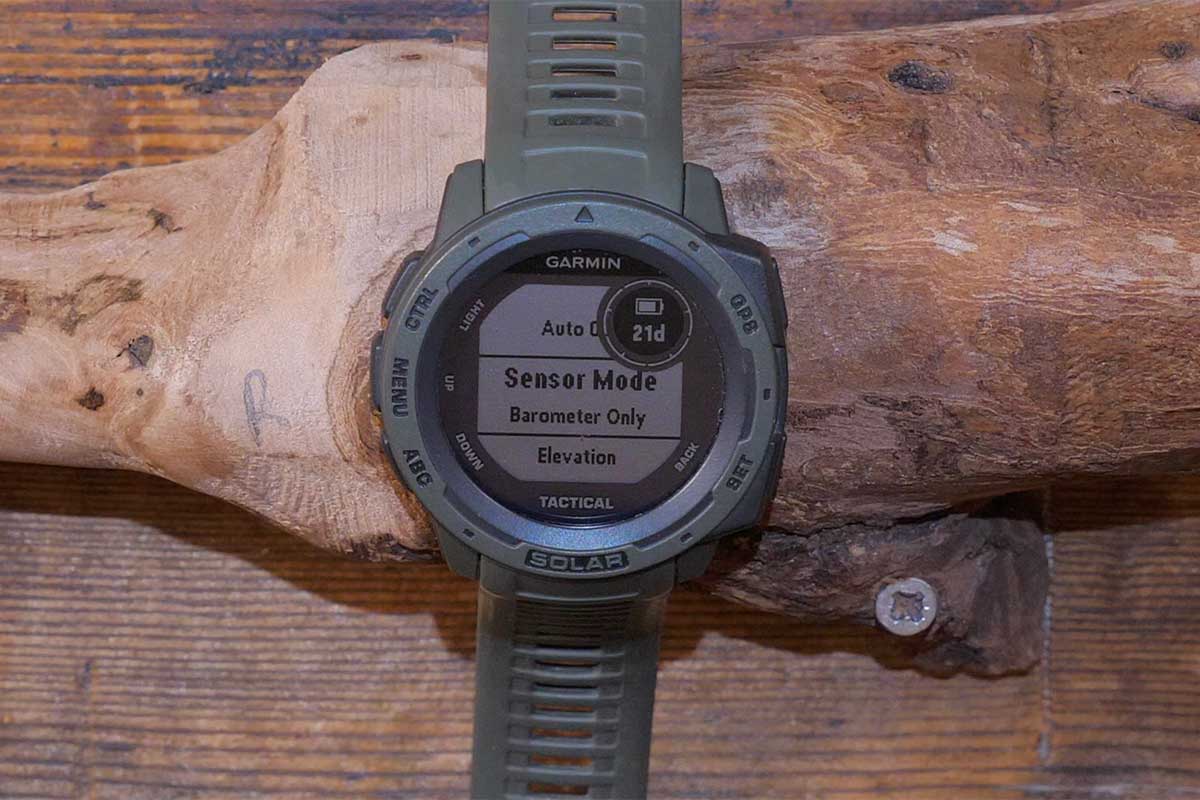
Although I do like the very nifty way of thinking of the Garmin Instinct series, I still feel more comfortable if I can tell the watch if the barometer should be in the lead or the altimeter. Well, I can choose them manually so there is no harm done; I can be in the lead. The best time to choose the Altimeter mode is when you are in the mountains and a lot of elevation changes are made. The barometer mode is best used in places where the change in pressure must be a result of barometric pressure changes like in my totally flat Netherlands.
Storm or weather alarm
One thing that I always like in outdoor watches is the storm or weather alarm. This alarm warns me if the barometric pressure rises or drops very fast in a short period of time. In most cases this is the indication that a change in weather is coming fast and most of the time it is not fair weather that is closing in. The Instinct has such a storm or weather alarm and it is operated by the barometer. Setting it is just a matter of pressing the Set-botton for a few seconds and setting the right values.
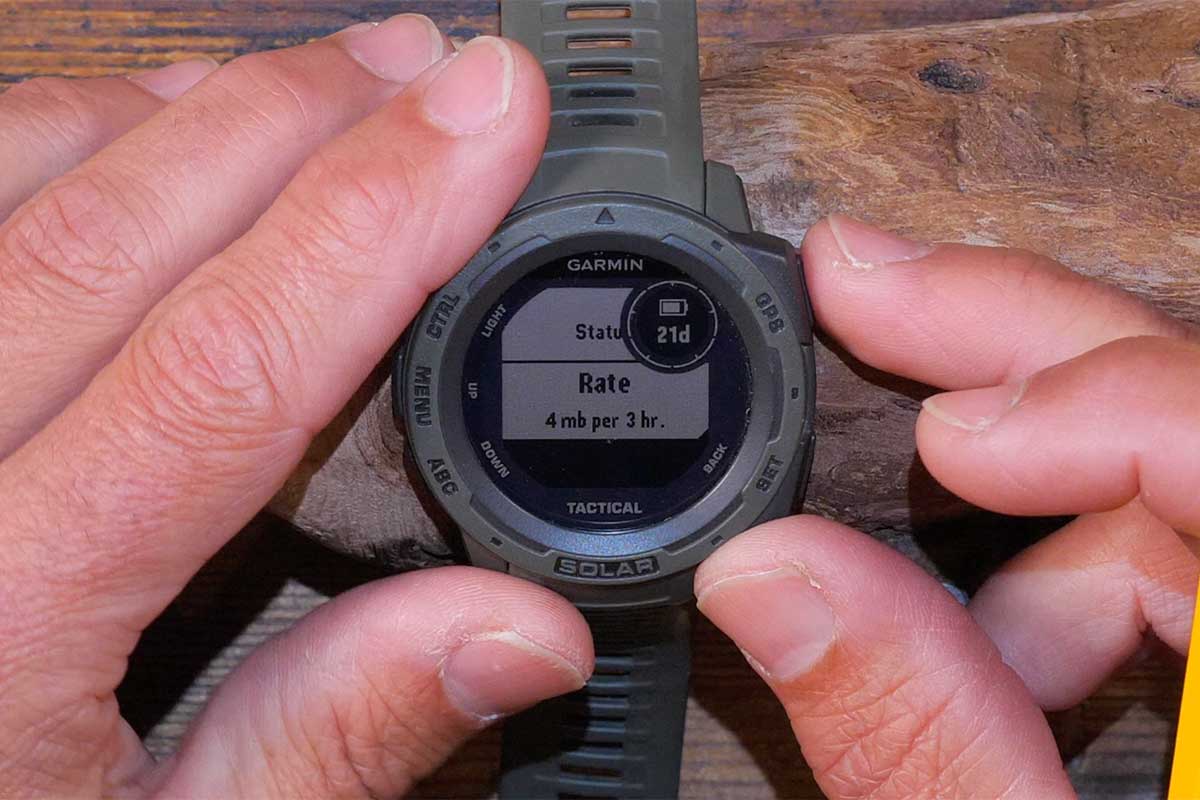
Altimeter and barometer calibration
One thing that is also done automatically by the Instinct and the algorithm, is the calibration of the altimeter/barometer. Calibrating is necessary to get the most accurate readings. Everytime you start an activity on the Instinct the watch automatically calibrates by using the GPS. Calibrating by GPS-height is fine but is of course influenced by satellite coverage and can be quite inaccurate. Garmin even states that the inaccuracy can be up to 120 meters. In a mountainous area this is a lot. Therefore Garmin advises to calibrate manually and I couldn’t agree more.
The manual calibration of the Garmin Instinct for both altimeter and barometer is done by setting a known altitude. This can be the height of a landmark on the map where you are, a sign or for example a mountain hut. The more often the watch is calibrated, the more accurate the measurement.
By the way: In practice in the Alpes last summer the Altimeter has proven to be fast adapting to the changing altitude and very accurate!
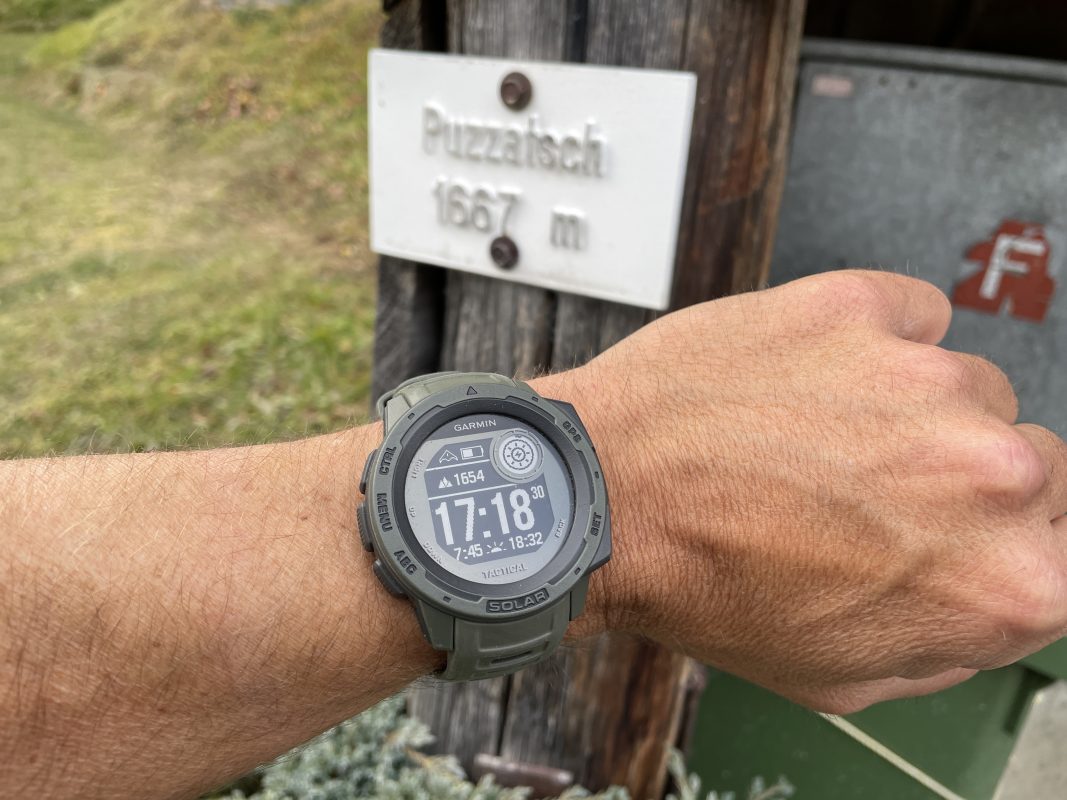
Smartphone connection
Like most outdoor watches the Instinct can – or must be – connected to a smartphone. In the Garmins case it uses the Garmin Connect – for smartphone and computer – to send data up and forth. Data that I collected when logging for example heart rate and the route during my evening run. The app shows a lot of information on my activities and what I like best: it is user friendly. Garmin Connect is also used to update the firmware in the watch and it works flawless.
Also like most smartwatches the Garmin takes over a part of the smartphone functions: I like the fact that it shows messages so I don’t have to grab my phone. I can also use the ‘Find my phone’ function in case I lose my iPhone. Be aware that it uses the bluetooth connection to find your smartphone so when the connection is lost…
Weather forecast
Because of the smartphone connection the watch also downloads weather data. These data can be handy when outdoors but you cannot use it in areas where there is no smartphone coverage. I am so happy that Garmin uses the barometer also for the barometric trend and I can do my own forecast.
Tactical
Since this is the tactical edition of the Garmin Instinct I need to write a few lines on the tactical functions. The first one being the readability of the watch face in night vision mode. This means that if you are wearing night vision goggles you are able to read the watch without the risk of being blinded by the watch’s light.
The second one is that the Instinct is able to display the Universal Transverse Mercator (UTM) grid system and the Military Grid Reference System (MGRS) at the same time. The third one is the Stealth mode that switches the storage and sharing of gps data off and turns the watches function to offline so no data is being transmitted. For me not being in military circumstances ever the tactical functies are not that useful but I can imagine that for people who are in tactical situations this can be key.

Charging the Garmin Instinct Solar Tactical Part 2
As I mentioned in the beginning of this article I would get back on the solar charging of the Garmin Instinct Solar. After half a year of use I am not too sure about the solar charging part of the watch. This deserves explanation.
Garmin does not provide data on what the relation is between the intensity of the sun and the charging time but they do provide data on the effect of the sun onto the battery time. In all cases they calculate for how long the watch will keep on going when it is exposed to 50.000 lux for 3 hours a day.
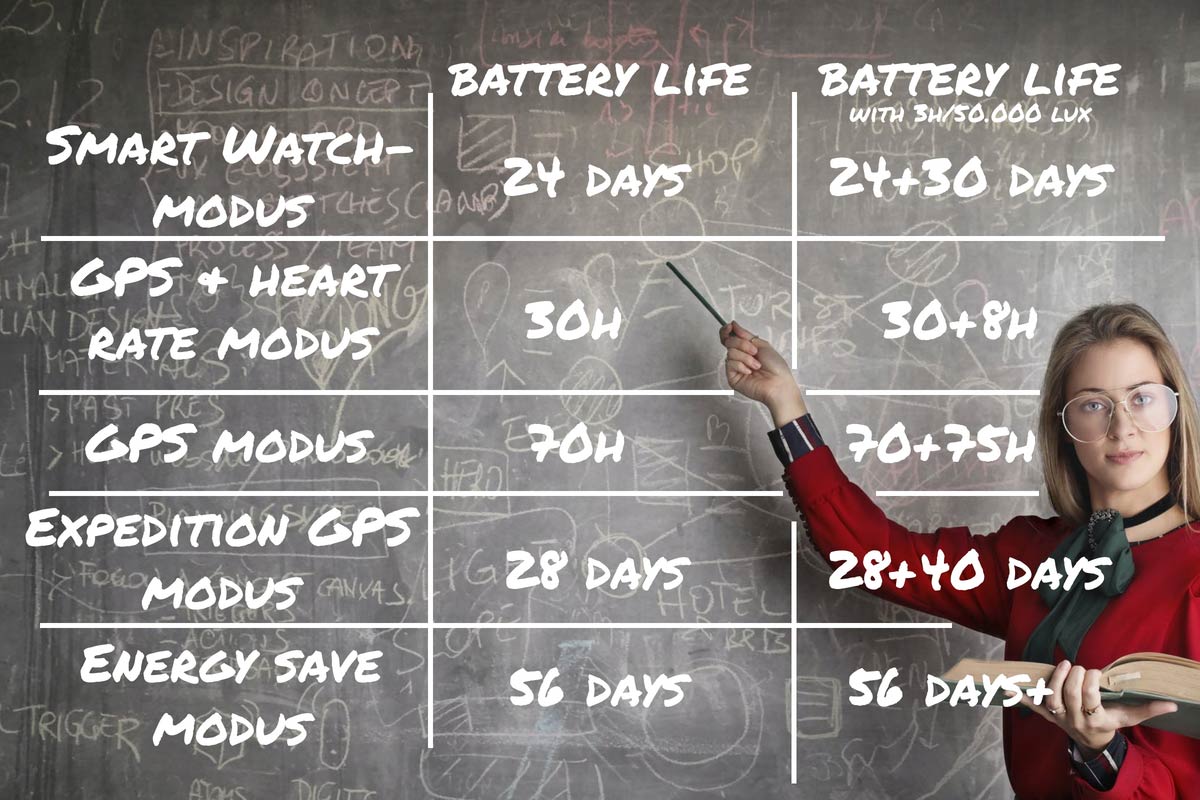
Did I check them all? No, I have better things to do but I did some measurements and I have my own observations.
In the first place I noticed that the ideal circumstances for the Garmin to use the solar panel are pretty rare in my outdoor life. The watch is most of the time on my wrist and it is moving everywhere. Seldom it is facing the sun in a way that the sunlight hits the solar panel to start charging efficiently.
And now I am talking about bright days with a lot of sun and wearing a t-shirt. I had one ideal day: sitting on a terrace of a mountain hut where I could put the watch on the table and the sunray hitting it perfectly. On colder days in wintertime with grey Dutch skies and wearing a jacket charging is very little. Let me share some measurements.
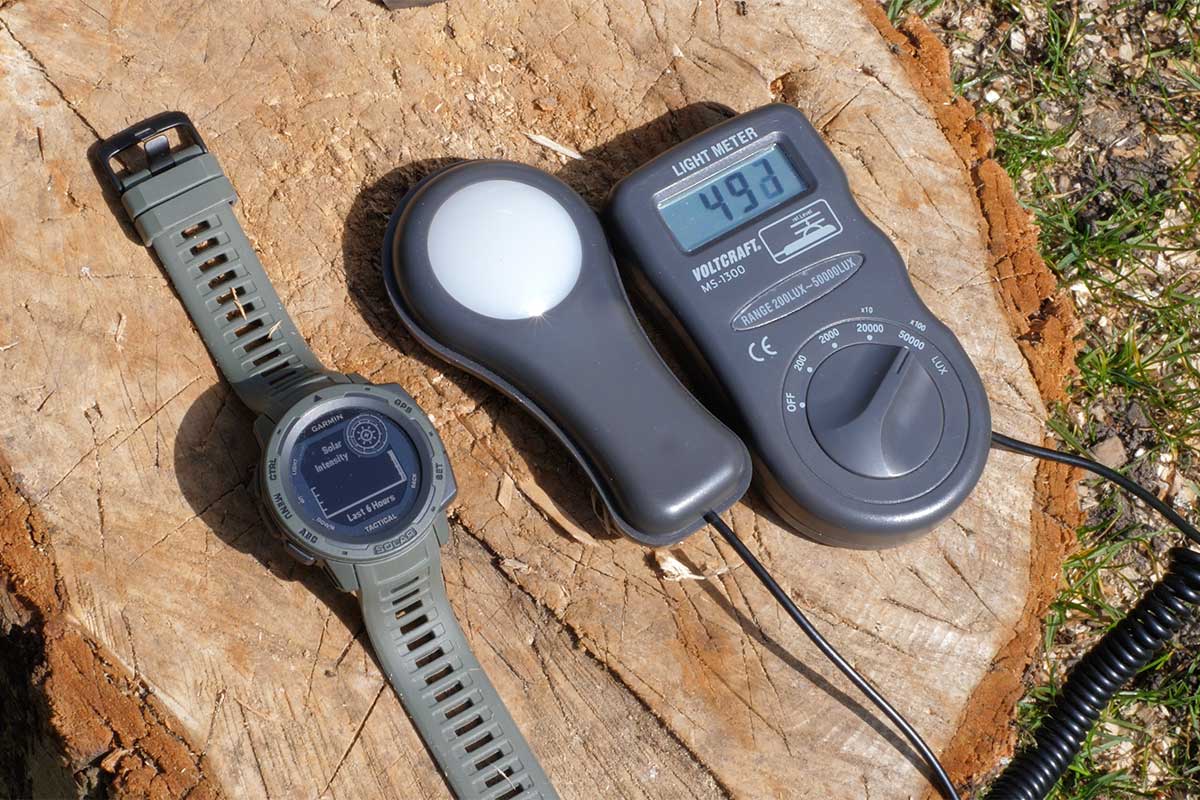
On a sunny day the sun produces about 50-100.000 lux. With a lux meter I measured a couple of days outdoors and how much sun hits Garmin Instinct Solar.
On a bright clear day in late autumn and early spring I measured about 52000 lux with the lux meter and the watch facing the sun directly. These are ideal circumstances.
With the watch on my wrist, the lux meter next to it and walking with both facing the sun direction but not holding them perfectly in the sun, I measure about 30.000 lux.

Doing the same but walking the opposite direction so that the watch face is not facing the sun, the amount of lux drops dramatically to 2300 lux.
Doing the same on a day with overcast results in almost the same measurements as on a sunny day and keeping the Instinct in the shade.
Where do Garmins battery life numbers and my measurements lead to? Well in the first place I am able to confirm that the minimum of 24 hour battery life with the heart rate monitor on is pretty accurate. In Energy save mode I can only guess. Yes, I tried it but after a while I did not bother looking at the watch anymore and all of a sudden it was empty. 56 days? 60? 50? Don’t know but it was long enough! The fact that the solar panel extends battery life is true without a doubt but in my outdoor life it has not proven efficient and handy enough. And I am hardly in the circumstances that I am off grid and I don’t have the possibility to charge the watch with the USB cable and a wall socket or computer.
Rugged comfort
I mentioned it also in the beginning of this article. The Garmin Instinct Solar Tactical has a weight of a meager 53 grams and a size of only 45 x 45 x 15,3 mm. And these numbers are probably why I like the Instinct so much. I am a small guy with small wrists and the Instinct – any Instinct – just fits perfectly and does not feel as I am wearing a vault on my wrist. The screen is big enough to read the letters and the numbers and also the buttons are big enough. Only with gloves they are a bit challenging from time to time. Because the watch is not humongous it also fits comfortably under the sleeve of a jacket. And I never felt the small smooth hill with the optical sensors in it. So comfort is top notch!
Remains the question: is it rugged? To my standards absolutely. The watch has proven to be waterproof, it takes a beating and does not suffer from being bashed into trees or the occasional rock. But that is just the G-F-OGS-2021 ‘Gijs-from-outdoorguru-standard’.

MIL-STD-810G
For those who are interested; the Garmin Instinct Solar Tactical is built to US military standard MIL-STD-810G for thermal, shock and water resistance. Built to does not mean to my opinion that it is MIL-STD-810G certified. This is what Garmin writes about the MIL-STD-810G:
“In tests for high-altitude performance using MIL-STD-810G’s Method 500.6 (Procedure I and II), the Instinct was operational at altitudes as high as 12,000 feet, and can be stored at altitudes of 40,000 feet (international flight cruising altitude). Following Procedure IV of Method 516.7 (Pendulum Impact), the Instinct remained undamaged after multi-directional shock testing from a drop distance of 122cm. Under Method 524.1’s protocols for testing freeze-thaw (Procedures II and III) at temperature changes of less than 3°C per minute, the Instinct withstood multiple simulated high-altitude freezing-point cycles as well as freezing from room temperature, all without impaired functioning.
Additionally, the Instinct was able to pass corrosion testing under Method 509.6: spraying it with salt-fog for 24 hours and then drying for an additional 24 hours produced no corrosion, guaranteeing that the Instinct retains its durability in salt-rich maritime environments.”
I don’t have an opinion on the above except for the fact that I think Garmin takes the Instinct Solar Tactical serious. I am just not sure if ‘built to’ is something I would shout of the rooftops and maybe it should say ‘meets MIL-STD-810G standards’ or is ‘MIL-STD-810G certified’.
Verdict
The Garmin Instinct Solar Tactical has been with me for about 6 months and the best thing I like about it is the size on my wrists and the low weight of only 53 grams. It is very comfortable to wear and also fits well under the sleeve of a jacket. The screen is big enough to read the numbers comfortably and the 5 buttons are very usable too. Only gloved up can be tricky at times. The watch is loaded with features that are easy to use and match my sport- and outdoor life. I like the way the barometer and the altimeter are designed and work are super and the compass does what it needs to do. The Instinct and the Garmin Connect app work seamless and the app is easy to use.
The watch meets my standards for waterproofness and ruggedness. I have my doubts about the solar part. In ideal circumstances it will do what Garmin promises but in my daily active life outdoors I don’t really see the benefit; my wrist and watch are hardly ever in an ideal solar panel position. For me the regular non solar Garmin Instinct Tactical would be fine although I can’t beef about the sustainable solar-capabilities anymore when sitting around the campfire with friends… Decide for yourself if you want to spend the extra money. The Garmin Instinct Solar Tactical retails for € 399,99/ $ 449,99/ £359,99 and the non solar for € 299,99/ $ 299,99/ £319,99 and both are worth the money spent. I rate the Garmin Instinct Solar Tactical at 9,2 out of 10 points total.
Information
International: www.garmin.com
For the Dutch: www.garmin.com/nl-NL/
